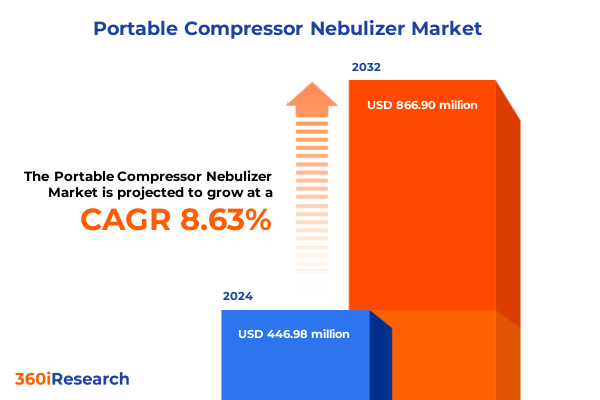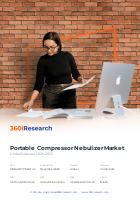The Portable Compressor Nebulizer Market size was estimated at USD 446.98 million in 2024 and expected to reach USD 485.66 million in 2025, at a CAGR of 8.63% to reach USD 866.90 million by 2032.

Understanding the Escalating Prevalence of Respiratory Disorders and Emergence of Portable Compressor Nebulizers as Critical Care Solutions
The global burden of respiratory illnesses continues to escalate, with asthma impacting 8.2% of the U.S. population and chronic obstructive pulmonary disease diagnosed in 3.8% of adults in 2023 according to the National Health Interview Survey. Asthma prevalence reached nearly 26.8 million Americans, including 4.5 million children, while COPD contributed to over 140,000 deaths and burdened healthcare systems with annual costs exceeding $24 billion in 2023. This rising prevalence underscores the critical need for effective, patient-centric respiratory therapy solutions.
Navigating Pioneering Technological, Regulatory, and Patient-Centric Transformations Redefining the Portable Compressor Nebulizer Landscape Worldwide
Over the past decade, the portable compressor nebulizer market has undergone profound transformation driven by technological innovation, regulatory acceleration, and heightened patient expectations. The advent of smart nebulizing devices, capable of wireless connectivity and real-time adherence tracking, has markedly enhanced treatment compliance among pediatric patients under five years old, demonstrating adherence increases exceeding 20% in controlled studies of smart versus conventional nebulizers. Concurrently, mesh and ultrasonic technologies have matured, offering quieter operation, reduced treatment times, and higher fine-particle generation that optimize drug delivery and mitigate dosage loss. Regulatory bodies have responded by streamlining accelerated pathways for digital health components, enabling faster market entry for devices incorporating remote monitoring and advanced safety features. As a result, patient-centric care models have evolved to integrate home-based respiratory therapy platforms, supported by telehealth services that reinforce continuity of care and enable clinicians to adjust regimens based on objective usage data.
Assessing the Far-Reaching Financial and Operational Repercussions of Newly Imposed 2025 United States Tariffs on Portable Compressor Nebulizer Supply Chains
The introduction of enhanced Section 301 tariffs has reshaped cost structures and supply chain strategies across the portable nebulizer ecosystem. Effective January 1, 2025, tariffs on rubber medical gloves and disposable facemasks rose to 50%, while semiconductors and related device components saw increases up to 50%, directly impacting production costs for key device elements manufactured in China. GE Healthcare anticipates a $500 million tariff-related expense in 2025, with $375 million attributed to China-origin components, prompting accelerated localization initiatives in 2026 to mitigate these effects. Fitch Solutions projects that the cumulative financial burden could drive a 10–15% increase in unit costs for imported devices, compelling manufacturers to reevaluate offshore assembly strategies and reinforcing the trend toward diversified sourcing and in-country production to preserve margin integrity.
Dissecting Core Market Segments Across Device Types, Patient Demographics, Therapeutic Applications, Distribution Channels and End Users to Unveil Strategic Opportunities
Distinct performance attributes define each device type segment, from piston-pump nebulizers known for their robust durability to ultrasonic models prized for near-silent operation and vibrating mesh devices lauded for their high fine-particle efficiency. Preferences shift across patient demographics, as adult end users typically favor compact, high-throughput compressors, while geriatric and pediatric cohorts require ergonomic designs with simplified interface modalities. Therapeutic applications reveal that asthma, encompassing both allergic and non-allergic forms, dominates utilization patterns, though chronic obstructive pulmonary disease, bronchitis, and cystic fibrosis constitute critical submarkets requiring specialized aerosolization profiles. Distribution channel dynamics further shape adoption, as direct sales foster bespoke clinical procurement, hospital pharmacy networks underpin institutional deployments, and the proliferation of online retail channels accelerates homecare uptake. Meanwhile, end-user environments range from ambulatory care centers and clinics to at-home care settings, with hospitals segmented into general wards and intensive care units, each imposing unique operational and technical requirements on device performance and sterilization protocols.
This comprehensive research report categorizes the Portable Compressor Nebulizer market into clearly defined segments, providing a detailed analysis of emerging trends and precise revenue forecasts to support strategic decision-making.
- Device Type
- Patient Group
- Therapeutic Application
- End User
- Distribution Channel
Analyzing Regional Dynamics and Healthcare Infrastructure Variations in the Americas, Europe Middle East & Africa and Asia-Pacific to Drive Market Penetration Strategies
Within the Americas, the United States leads home-based respiratory therapy adoption, with medical supply expenses accounting for 10.5% of average hospital budgets and totaling $146.9 billion in 2023, driving demand for portable compressor nebulizers that enable cost-effective at-home care and reduce inpatient resource utilization. In Europe, the nebulizer market reached approximately $340 million in 2024, propelled by an aging population and increasing prevalence of respiratory disorders, and is projected to surpass $630 million by 2033, supported by robust reimbursement frameworks and harmonized CE-marking regulations. Asia-Pacific emerges as the fastest-growing region, fueled by rising chronic respiratory disease burden-over 10% of regional mortality-and expansive healthcare investments in China and India, where localized manufacturing initiatives and government health schemes bolster portable device accessibility across urban and rural populations alike.
This comprehensive research report examines key regions that drive the evolution of the Portable Compressor Nebulizer market, offering deep insights into regional trends, growth factors, and industry developments that are influencing market performance.
- Americas
- Europe, Middle East & Africa
- Asia-Pacific
Profiling Leading Manufacturers and Innovative Market Entrants Shaping Competitive Advantage in the Portable Compressor Nebulizer Sector Through Strategic Initiatives
Global industry incumbents maintain differentiated competitive positions through extensive product portfolios, strategic alliances, and continuous innovation cycles. Leaders like Philips Respironics and Omron Healthcare leverage decades of clinical validation and broad distribution networks to reinforce brand trust in both hospital and homecare channels. Specialized players such as PARI GmbH and Drive DeVilbiss Healthcare emphasize therapeutic depth, with devices tailored to nuanced patient needs in asthma and cystic fibrosis management. Meanwhile, Medline Industries and Becton, Dickinson and Company harness integrated supply chain capabilities to deliver end-to-end solutions encompassing device, consumable, and service offerings. Emerging entrants, including Aerogen and Yuwell-Jiangsu Yuyue, challenge incumbents through cost-optimized manufacturing and targeted market entry in emerging economies. Strategic partnerships with pharmaceutical companies, hospital groups, and digital health providers further amplify competitive advantage by embedding nebulization solutions into broader care pathways.
This comprehensive research report delivers an in-depth overview of the principal market players in the Portable Compressor Nebulizer market, evaluating their market share, strategic initiatives, and competitive positioning to illuminate the factors shaping the competitive landscape.
- 3M Company
- Aerogen Ltd
- Agilent Technologies Inc
- Allied Healthcare Products Inc
- Beurer GmbH
- BMC Medical Co Ltd
- Cipla Limited
- Drive DeVilbiss Healthcare LLC
- GE HealthCare Technologies Inc
- GF Health Products Inc
- Invacare Corporation
- Jiangsu Yuyue Medical Equipment & Supply Co Ltd
- Koninklijke Philips N.V.
- Landwind Health Care Inc
- Medline Industries Inc
- Medtronic
- Microlife Corporation
- Narang Medical Limited
- Omron Corporation
- PARI GmbH
- ResMed
- Rossmax International Ltd
- Smiths Group plc
- Vyaire Medical Inc
Delivering Strategic Roadmaps and Tactical Recommendations to Empower Industry Leaders to Capitalize on Emerging Trends and Mitigate Supply Chain Disruptions
Industry leaders are urged to establish dual-sourced manufacturing footprints that integrate near-shore and local assembly to insulate against tariff volatility while preserving cost efficiencies. Collaborations with logistics providers to implement tariff classification audits and secure exclusion pathways can yield immediate duty savings. Organizations should accelerate deployment of digital health platforms that pair nebulizer devices with remote monitoring and data analytics to differentiate value propositions and enhance patient retention. Investments in modular product architectures will enable rapid adaptation to evolving therapeutic formats and regulatory requirements. Finally, forging cross-sector partnerships with payers and homecare agencies can facilitate bundled care models, aligning incentives around improved outcomes and total cost of care reductions.
Outlining Comprehensive Research Framework Combining Primary Engagements and Rigorous Secondary Analysis Ensuring Data Integrity and Industry Relevance
This report synthesizes insights from rigorous secondary research, including analysis of United States Trade Representative Section 301 tariff announcements, FDA device registration databases, and national health statistics such as the National Health Interview Survey and Behavioral Risk Factor Surveillance System. Primary data collection encompassed structured interviews with senior executives at leading nebulizer manufacturers, hospital procurement directors, and clinical respiratory therapists. Quantitative data were validated through cross-referencing proprietary industry shipment databases and public financial disclosures. Regional market dynamics were assessed via triangulation of source studies, including government reports and international trade publications. Methodological rigor was maintained through iterative stakeholder review, ensuring data integrity, relevance, and alignment with the latest industry developments.
This section provides a structured overview of the report, outlining key chapters and topics covered for easy reference in our Portable Compressor Nebulizer market comprehensive research report.
- Preface
- Research Methodology
- Executive Summary
- Market Overview
- Market Insights
- Cumulative Impact of United States Tariffs 2025
- Cumulative Impact of Artificial Intelligence 2025
- Portable Compressor Nebulizer Market, by Device Type
- Portable Compressor Nebulizer Market, by Patient Group
- Portable Compressor Nebulizer Market, by Therapeutic Application
- Portable Compressor Nebulizer Market, by End User
- Portable Compressor Nebulizer Market, by Distribution Channel
- Portable Compressor Nebulizer Market, by Region
- Portable Compressor Nebulizer Market, by Group
- Portable Compressor Nebulizer Market, by Country
- Competitive Landscape
- List of Figures [Total: 30]
- List of Tables [Total: 579 ]
Synthesizing Critical Findings and Formulating Cohesive Narratives to Illuminate Strategic Imperatives for Stakeholders in the Portable Compressor Nebulizer Market
The portable compressor nebulizer market stands at a critical inflection point, shaped by accelerating technological innovation, evolving regulatory environments, and shifting patient care paradigms. While tariff headwinds pose short-term cost challenges, they concurrently catalyze strategic localization and supply chain diversification, reinforcing the resilience of market participants. Segmentation analysis highlights targeted opportunities across device types, patient groups, therapeutic applications, distribution channels, and end users, underscoring the importance of tailored solutions. Regional insights reveal divergent adoption trajectories, with North America emphasizing homecare expansion, Europe driving through reimbursement and regulatory harmonization, and Asia-Pacific demonstrating robust growth fueled by public health initiatives. Leading companies must leverage digital health integration, agile manufacturing, and collaborative care models to secure competitive advantage and sustain long-term growth.
Connect Directly with Ketan Rohom to Secure Exclusive Portable Compressor Nebulizer Market Insights and Propel Your Strategic Decisions
To embark on a journey toward market clarity and strategic advantage, reach out to Ketan Rohom, Associate Director of Sales & Marketing, for an in-depth discussion and tailored insights. Ketan’s expertise will guide you in unlocking the full potential of this comprehensive market research report and help you fortify your strategic roadmap. Contact Ketan Rohom today to secure your copy and position your organization at the forefront of innovation within the portable compressor nebulizer industry.

- How big is the Portable Compressor Nebulizer Market?
- What is the Portable Compressor Nebulizer Market growth?
- When do I get the report?
- In what format does this report get delivered to me?
- How long has 360iResearch been around?
- What if I have a question about your reports?
- Can I share this report with my team?
- Can I use your research in my presentation?




